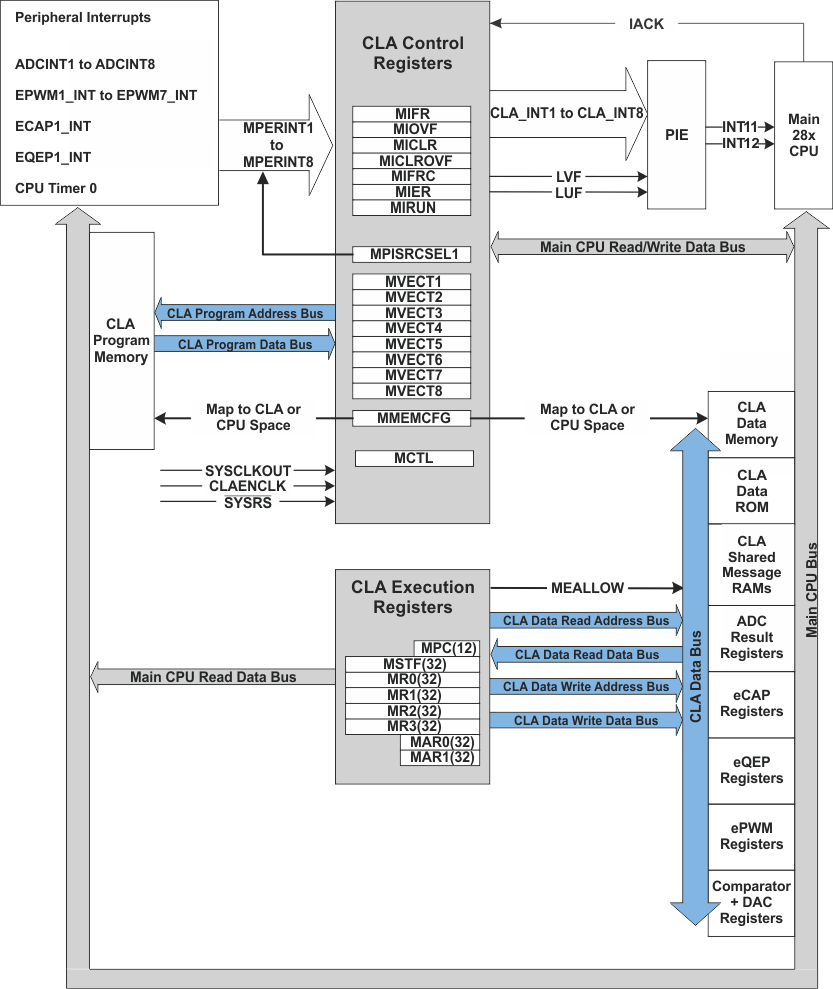SPRS797F November 2012 – September 2021 TMS320F28050 , TMS320F28051 , TMS320F28052 , TMS320F28052F , TMS320F28052M , TMS320F28053 , TMS320F28054 , TMS320F28054F , TMS320F28054M , TMS320F28055
PRODUCTION DATA
- 1 Features
- 2 Applications
- 3 Description
- 4 Revision History
- 5 Device Comparison
- 6 Terminal Configuration and Functions
-
7 Specifications
- 7.1 Absolute Maximum Ratings
- 7.2 ESD Ratings – Commercial
- 7.3 ESD Ratings – Automotive
- 7.4 Recommended Operating Conditions
- 7.5 Power Consumption Summary
- 7.6 Electrical Characteristics
- 7.7 Thermal Resistance Characteristics for PN Package
- 7.8 Thermal Design Considerations
- 7.9 JTAG Debug Probe Connection Without Signal Buffering for the MCU
- 7.10 Parameter Information
- 7.11 Test Load Circuit
- 7.12 Power Sequencing
- 7.13 Clock Specifications
- 7.14 Flash Timing
-
8 Detailed Description
- 8.1
Overview
- 8.1.1 CPU
- 8.1.2 Control Law Accelerator
- 8.1.3 Memory Bus (Harvard Bus Architecture)
- 8.1.4 Peripheral Bus
- 8.1.5 Real-Time JTAG and Analysis
- 8.1.6 Flash
- 8.1.7 M0, M1 SARAMs
- 8.1.8 L0 SARAM, and L1, L2, and L3 DPSARAMs
- 8.1.9 Boot ROM
- 8.1.10 Security
- 8.1.11 Peripheral Interrupt Expansion Block
- 8.1.12 External Interrupts (XINT1 to XINT3)
- 8.1.13 Internal Zero-Pin Oscillators, Oscillator, and PLL
- 8.1.14 Watchdog
- 8.1.15 Peripheral Clocking
- 8.1.16 Low-power Modes
- 8.1.17 Peripheral Frames 0, 1, 2, 3 (PFn)
- 8.1.18 General-Purpose Input/Output Multiplexer
- 8.1.19 32-Bit CPU-Timers (0, 1, 2)
- 8.1.20 Control Peripherals
- 8.1.21 Serial Port Peripherals
- 8.2 Memory Maps
- 8.3 Register Map
- 8.4 Device Emulation Registers
- 8.5 VREG, BOR, POR
- 8.6 System Control
- 8.7 Low-power Modes Block
- 8.8 Interrupts
- 8.9
Peripherals
- 8.9.1 Control Law Accelerator
- 8.9.2
Analog Block
- 8.9.2.1
Analog-to-Digital Converter
- 8.9.2.1.1 ADC Device-Specific Information
- 8.9.2.1.2 ADC Electrical Data/Timing
- 8.9.2.2 Analog Front End
- 8.9.2.1
Analog-to-Digital Converter
- 8.9.3 Detailed Descriptions
- 8.9.4 Serial Peripheral Interface
- 8.9.5 Serial Communications Interface
- 8.9.6 Enhanced Controller Area Network
- 8.9.7 Inter-Integrated Circuit
- 8.9.8 Enhanced Pulse Width Modulator
- 8.9.9 Enhanced Capture Module
- 8.9.10 Enhanced Quadrature Encoder Pulse
- 8.9.11 JTAG Port
- 8.9.12 General-Purpose Input/Output
- 8.1
Overview
- 9 Applications, Implementation, and Layout
- 10Device and Documentation Support
- 11Mechanical, Packaging, and Orderable Information
Package Options
Mechanical Data (Package|Pins)
- PN|80
Thermal pad, mechanical data (Package|Pins)
Orderable Information
8.9.1.1 CLA Device-Specific Information
The CLA extends the capabilities of the C28x CPU by adding parallel processing. Time-critical control loops serviced by the CLA can achieve low ADC sample to output delay. Thus, the CLA enables faster system response and higher frequency control loops. Using the CLA for time-critical tasks frees up the main CPU to perform other system and communication functions concurently. The following is a list of major features of the CLA.
- Clocked at the same rate as the main CPU (SYSCLKOUT).
- An independent architecture allowing CLA algorithm execution independent of the main C28x CPU.
- Complete bus architecture:
- Program address bus and program data bus
- Data address bus, data read bus, and data write bus
- Independent eight-stage pipeline.
- 12-bit program counter (MPC)
- Four 32-bit result registers (MR0–MR3)
- Two 16-bit auxillary registers (MAR0, MAR1)
- Status register (MSTF)
- Complete bus architecture:
- Instruction set includes:
- IEEE single-precision (32-bit) floating-point math operations
- Floating-point math with parallel load or store
- Floating-point multiply with parallel add or subtract
- 1/X and 1/sqrt(X) estimations
- Data type conversions.
- Conditional branch and call
- Data load and store operations
- The CLA program code can consist of up to eight tasks or ISRs.
- The start address of each task is specified by the MVECT registers.
- No limit on task size as long as the tasks fit within the CLA program memory space.
- One task is serviced at a time through to completion. There is no nesting of tasks.
- Upon task completion, a task-specific interrupt is flagged within the PIE.
- When a task finishes, the next highest-priority pending task is automatically started.
- Task trigger mechanisms:
- C28x CPU through the IACK instruction
- Task1 to Task7: the corresponding ADC, ePWM, eQEP, or eCAP module interrupt. For example:
- Task1: ADCINT1 or EPWM1_INT
- Task2: ADCINT2 or EPWM2_INT
- Task4: ADCINT4 or EPWM4_INT or EQEPx_INT or ECAPx_INT
- Task7: ADCINT7 or EPWM7_INT or EQEPx_INT or ECAPx_INT
- Task8: ADCINT8 or by CPU Timer 0 or EQEPx_INT or ECAPx_INT
- Memory and Shared Peripherals:
- Two dedicated message RAMs for communication between the CLA and the main CPU.
- The C28x CPU can map CLA program and data memory to the main CPU space or CLA space.
- The CLA has direct access to the CLA Data ROM that stores the math tables required by the routines in the CLA Math Library.
- The CLA has direct access to the ADC Result registers, comparator and DAC registers, eCAP, eQEP, and ePWM registers.
 Figure 8-15 CLA Block Diagram
Figure 8-15 CLA Block Diagram